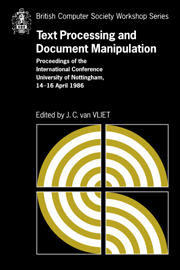 Text Processing and Document Manipulation
Text Processing and Document Manipulation Book contents
- Frontmatter
- Contents
- Preface
- The Design of Lucida®: an Integrated Family of Types for Electronic Literacy
- Tabular Typography
- A Simple Mechanism for Authorship of Dynamic Documents
- VORTEXT: VictORias TEXT reading and authoring system
- An Approach to the Design of a Page Description Language
- Intelligent Matching and Retrieval for Electronic Document Manipulation
- A Disciplined Text Environment
- Semantic Guided Editing: A Case Study On Genetic Manipulations
- Trends and Standards in Document Representation
- Textmaster – document filing and retrieval using ODA
- Combining Interactive Document Editing with Batch Document Formatting
- Formatting Structure Documents: Batch versus Interactive?
- Advanced Catalogue Production at Unipart
- Legibility of Digital Type-fonts and Comprehension in Reading
- An Overview of the W Document Preparation System
- Grif: An Interactive System for Structured Document Manipulation
- Procedural Page Description Languages
- A Strategy for Compressed Storage and Retrieval of Documents
- CONCEPT BROWSER: a System for Interactive Creation of Dynamic Documentation
- An Integrated, but not Exact-Representation, Editor/Formatter
- An Annotated Bibliography on Document Processing
- Systems used
An Integrated, but not Exact-Representation, Editor/Formatter
Published online by Cambridge University Press: 05 May 2010
- Frontmatter
- Contents
- Preface
- The Design of Lucida®: an Integrated Family of Types for Electronic Literacy
- Tabular Typography
- A Simple Mechanism for Authorship of Dynamic Documents
- VORTEXT: VictORias TEXT reading and authoring system
- An Approach to the Design of a Page Description Language
- Intelligent Matching and Retrieval for Electronic Document Manipulation
- A Disciplined Text Environment
- Semantic Guided Editing: A Case Study On Genetic Manipulations
- Trends and Standards in Document Representation
- Textmaster – document filing and retrieval using ODA
- Combining Interactive Document Editing with Batch Document Formatting
- Formatting Structure Documents: Batch versus Interactive?
- Advanced Catalogue Production at Unipart
- Legibility of Digital Type-fonts and Comprehension in Reading
- An Overview of the W Document Preparation System
- Grif: An Interactive System for Structured Document Manipulation
- Procedural Page Description Languages
- A Strategy for Compressed Storage and Retrieval of Documents
- CONCEPT BROWSER: a System for Interactive Creation of Dynamic Documentation
- An Integrated, but not Exact-Representation, Editor/Formatter
- An Annotated Bibliography on Document Processing
- Systems used
Summary
ABSTRACT
Integrated Editor/Formatters merge the document editing and formatting functions into a unified, interactive system. A common type of Integrated Editor/Formatter, the Exact-representation Editor/Formatter (also known as WYSIWYG), presents an interactive representation of the document that is identical to the printed document. Another powerful metaphor applied to documents has been to describe the document as abstract objects– to describe the document's logical structure, not its physical makeup. The goal of the research reported here is to merge the flexibility found in the abstract object-oriented approach with the naturalness of document manipulation provided by the Exact-representation Editor/Formatters. A tree-based model of documents that allows a variety of document objects as leaves (e.g., text, tables, and mathematical equations) has been defined. I suggest a template-oriented mechanism for manipulating the document and have implemented a prototype that illustrates the mechanism. Further work has concentrated on handling user operations on arbitrary, contiguous portions of the display.
Motivation and Goals of the Research
The world of text formatters can be divided into two parts. In one group are the pure formatters, which convert a document description, prepared by a separate editing system, into a formatted document suitable for display on an appropriate hardware device. In the other group are the Integrated Editor/Formatters, which merge the editing and the formatting functions into one unified, interactive system-documents are created, viewed, and revised without leaving the edit or/formatter.
- Type
- Chapter
- Information
- Text Processing and Document ManipulationProceedings of the International Conference, University of Nottingham, 14-16 April 1986, pp. 246 - 259Publisher: Cambridge University PressPrint publication year: 1986
- 1
- Cited by


